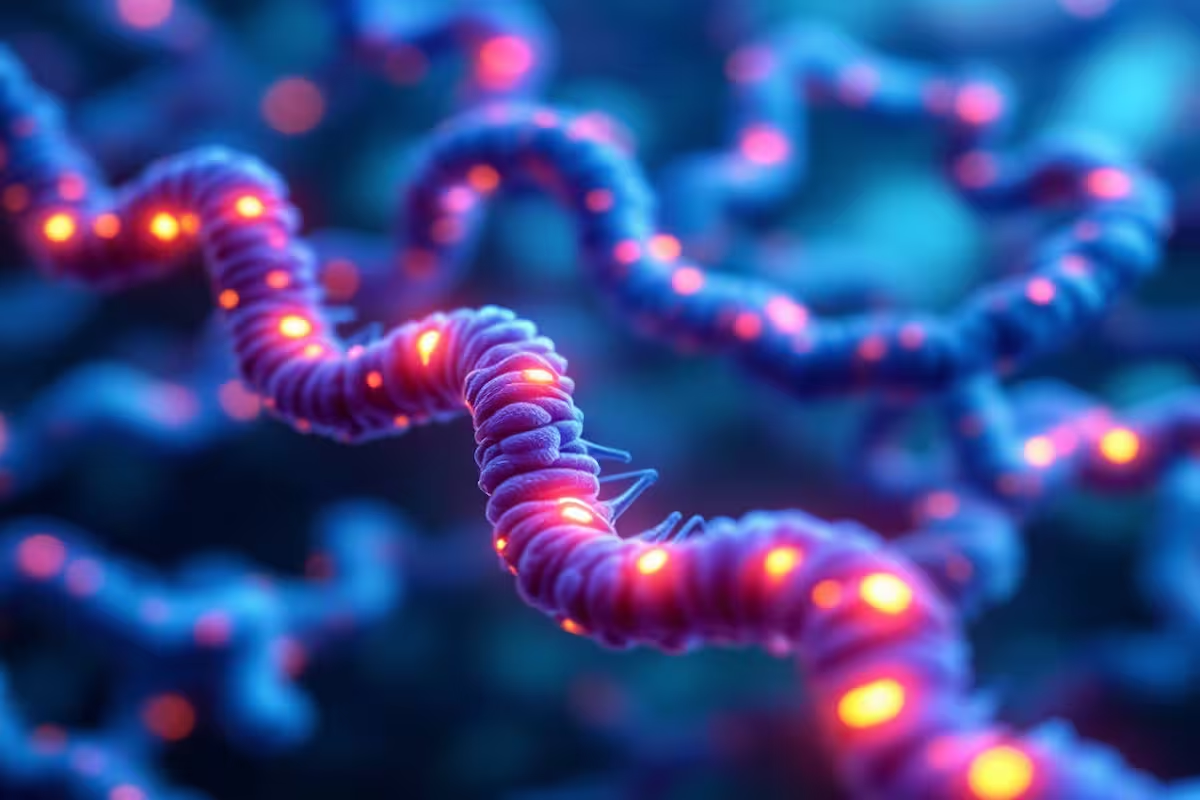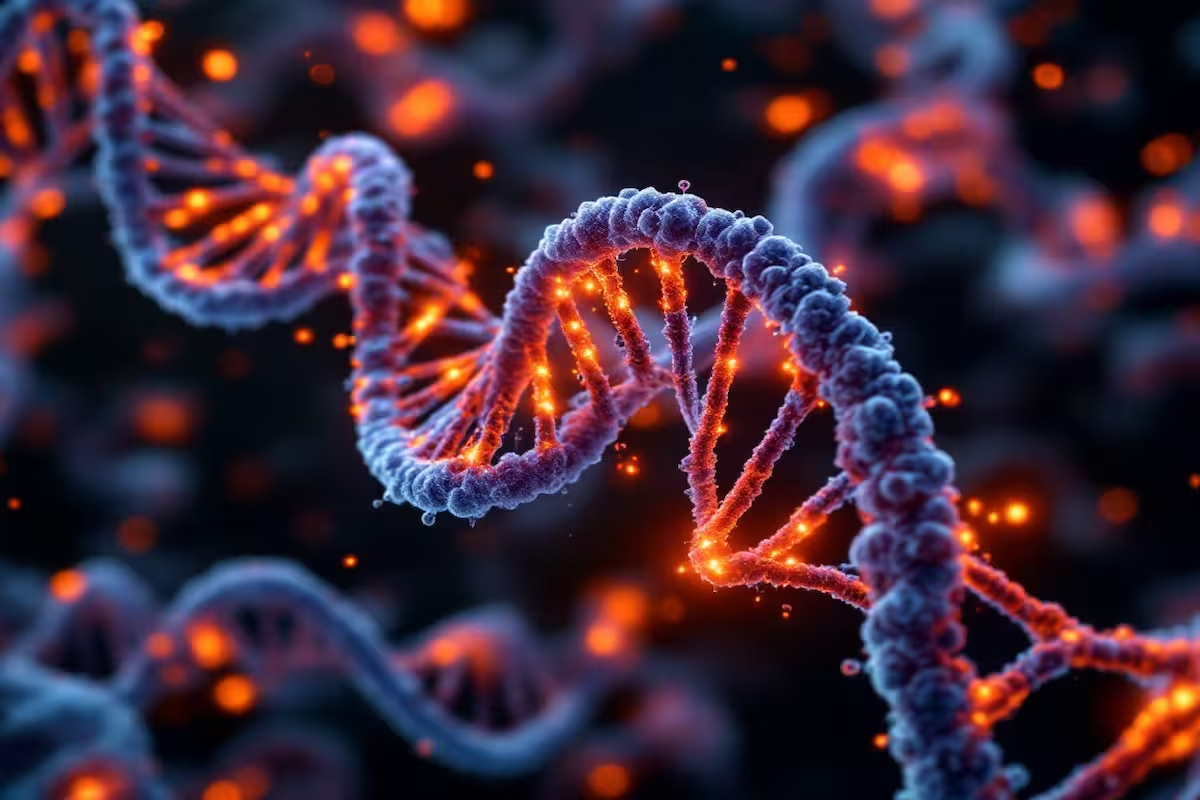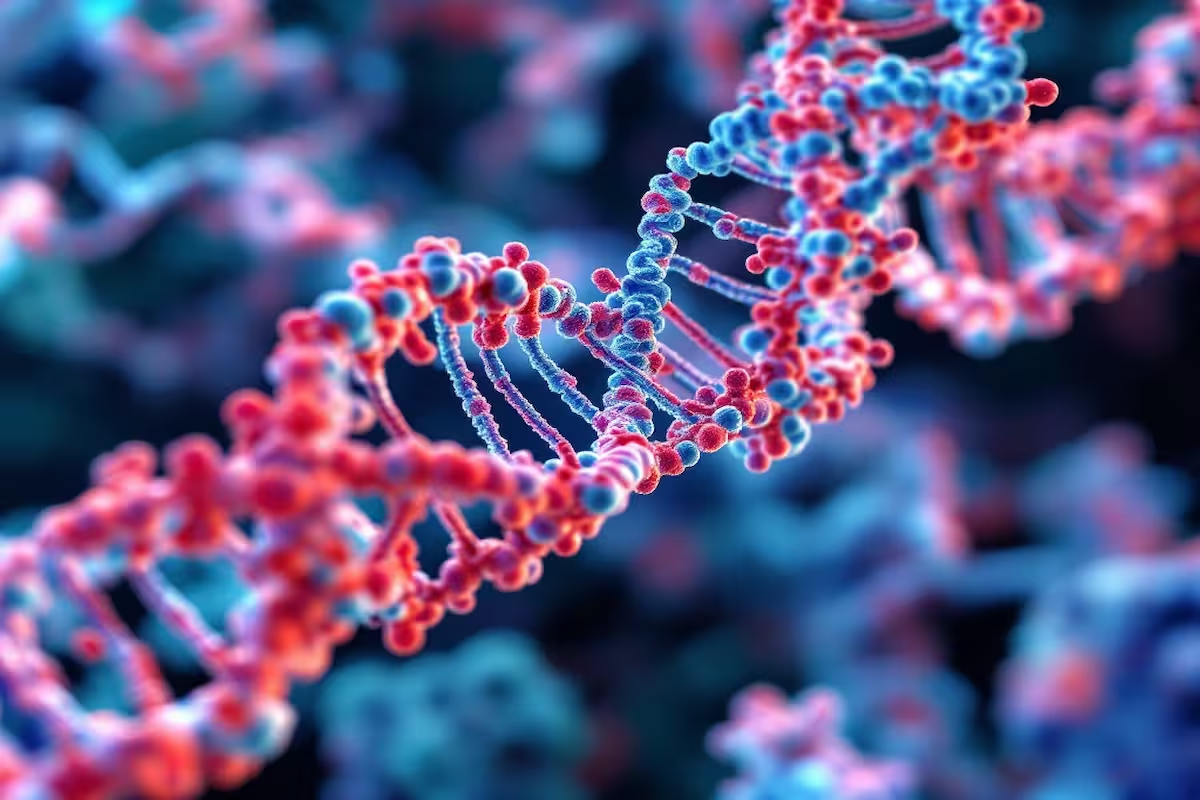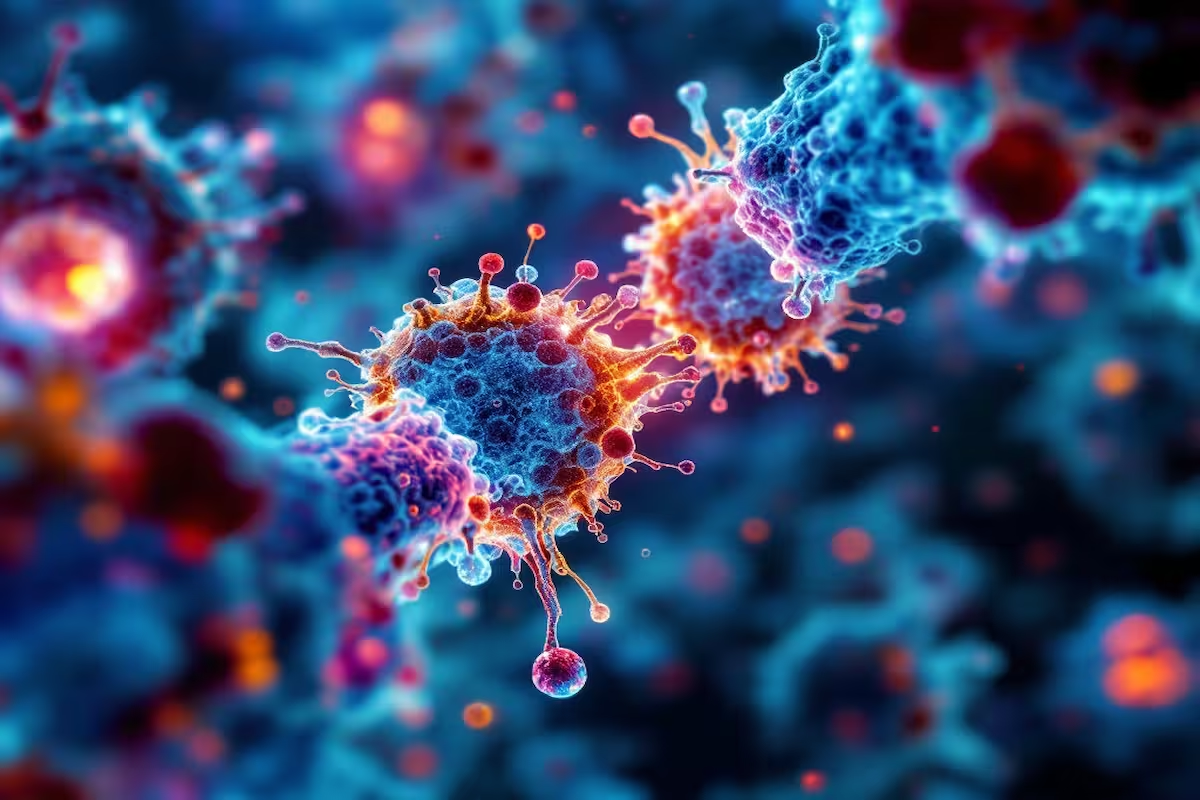In this article, we will address telomerase, an enzyme related to the cell life cycle, as well as various types of cancer.
Currently, there are various avenues of study on its possible manipulation in treatments against cancer and other diseases.
What is telomerase?
Telomerase is an RNA-dependent DNA polymerase that synthesizes repetitive telomeric DNA sequences at the 3′ ends of chromosomes, providing the molecular basis for the unlimited proliferative potential of cells.
This enzyme, a ribonucleoprotein, plays a role in maintaining telomeres, using an integral RNA (TER) as a template and a reverse transcriptase (TERT) to carry out the processive synthesis of these sequences, preserving genomic integrity during cell replication. (1,2,3).
Composition and molecular structure of telomerase
Telomerase is composed of two subunits (1,4):
- hTR (human telomerase RNA). It is the RNA component of telomerase and its main function is to serve as a template for adding new DNA sequences to the ends of telomeres. Telomerase uses hTR as a mold to copy specific repetitive DNA sequences (in humans, the sequence is TTAGGG).
- hTERT (human telomerase reverse transcriptase). It is the catalytic protein component of telomerase and responsible for the main enzymatic activity, which is reverse transcription. Reverse transcriptase is an enzyme that can create DNA from the RNA template. hTERT takes the RNA (hTR) and uses it to synthesize DNA at the ends of telomeres, catalyzing the addition of repetitive DNA sequences to telomeres.
Both hTR and hTERT work together as part of the complex of this enzyme to maintain telomere length, which has a vital function that we will see throughout the article.
Function of telomerase in cellular maintenance
In most human somatic cells, the proliferation potential is strictly limited, causing the progressive shortening of telomeres with each cell division, and eventually leading to senescence after approximately 50-70 cell divisions (4,7).
This is because DNA polymerase is not able to completely copy the DNA at the ends of chromosomes, resulting in a loss of about 50 nucleotides during each cell cycle, and therefore in the gradual shortening of telomeres (7).
Unlike somatic cells, certain populations of cells such as stem and germ cells maintain the activity of this enzyme, allowing prolonged replication.
However, telomerase activity is not sufficient to completely prevent telomere shortening in adult stem cells (4).
Maintaining telomere length is related to the self-renewal of human embryonic stem cells (hESCs) and induced pluripotent stem cells (hiPSCs) (6).
Telomere length is the result of the balance between telomeric elongation by the addition of guanine-rich repetitive sequences (7), mediated by this enzyme, and telomeric trimming, controlled by the proteins XRCC3 and Nbs1, involved in homologous recombination.
These proteins generate single-stranded cytosine-rich telomeric DNA (C-rich) and double-stranded circular telomeric DNA (T-circles), respectively (6).
This would lead us to an extension of human life and even argue the possibility of achieving indefinite life without the limitations of biological aging (5).
Telomerase activity is expressed in germ cells, stem cells, and tumor cells (7).
Telomerase and cellular aging
Telomeres are the protective ends of eukaryotic chromosomes and determine the proliferative lifespan of somatic cells, acting as protectors of cell replication.
The length of telomeres in leukocytes reflects the length of telomeres in other somatic cells and can be used as a biomarker of human aging (8).
Telomerase and cancer
The activity of this enzyme is absent in most normal human somatic cells, but it is present in more than 90% of cancer cells, as the unlimited proliferation activity in cancer cells is due to the activation of telomerase, which prevents telomere shortening (1).
Its activity is transcriptionally regulated, mainly through the expression of the hTERT gene.
In immortal cells, the hTERT promoter is active while in normal cells it is not. Additionally, epigenetic regulation (mediated by the environment) also influences hTERT expression (1).
Therefore, telomerase and its role in the immortalization of cancer cells is a potential target for anticancer therapies (1).
Previous studies indicate that telomerase plays a role in malignant transformation and tumor progression.
Specifically, prostate cancer was analyzed, showing that the expression of hTERT and hTR is increased in premalignant lesions such as high-grade prostatic intraepithelial neoplasia (PIN).
[article ids=”81951″] This suggests an important role of telomerase in the early stages of malignant transformation, but no significant correlation has been found between the expression of hTERT and hTR and the degree of tumor differentiation (3).
In most tumor cells, the replication potential is unlimited, but the catalytic inhibition of telomerase and the resulting cessation of telomere length maintenance could restrict the replication potential of tumor cells (7).
In most cancers, a telomere maintenance mechanism is necessary during DNA replication.
The reactivation of the functional ribonucleoprotein holoenzyme complex initiates the cascade from normal and premalignant somatic cells to advanced malignant cells, allowing cancer cells to maintain telomere integrity and avoid cellular senescence.
Stem cells and telomerase
Certain populations of stem cells, such as male germ cells and activated lymphocytes, maintain telomerase activity to protect their telomeres (1).
In addition to its involvement in stem cell function, it has been discovered that the TERT subunit of telomerase regulates functions including signal transduction, gene expression regulation, and protection against oxidative damage.
Furthermore, they are linked to mitochondria, the protection of reactive oxygen species, thus suggesting a protective role of TERT in neurons (9).
Diseases related to this enzyme
There are mutations in telomerase components, such as hTR or associated proteins like dyskerin associated with diseases such as dyskeratosis congenita, characterized by shortened telomeres and proliferative problems.
[article ids=”82023″] Telomere shortening correlates with an increased risk of diseases associated with decreased cell proliferation, such as dyskeratosis congenita, cardiovascular diseases, pulmonary fibrosis, and aplastic anemia (8).
Additionally, factors such as oxidative stress, inflammation, environmental surroundings, and therapeutic interventions affect telomere shortening, explaining the variability in telomere length among individuals (8).
Epigenetics and telomerase
Epigenetic modifications regulate telomerase activity, such as TERT promoter methylation and histone deacetylase (HDAC) inhibition (10).
Several microRNAs have been identified that directly target TERT regulation, showing efficacy in telomerase regulation, with potential use in cancer treatments (10).
What factors improve the activity of this enzyme?
As we know, the enzyme telomerase, through telomere length, is linked to both health and human mortality. However, there are different factors that can improve telomerase activity:
- Mindfulness. The practice of mindfulness meditation is associated with an increase in telomerase activity in peripheral blood mononuclear cells (10).
- Mental disorders. A decrease in telomerase activity was found in individuals under chronic stress, and an increase in its activity in people with major depressive disorder (11).
- Lifestyle. An increase in telomerase activity was found as a result of interventions related to physical exercise, meditation, dietary supplementation, and the practice of yoga or Qigong (11).
- Physical exercise. It was found that physical exercise has the potential to increase TERT expression and telomerase activity in non-cancerous somatic cells (12).
- The Mediterranean diet, rich in antioxidants, fibers, vegetables, seeds, and nuts, is associated with greater telomere length. In contrast, high consumption of sugary drinks, processed meats, and pro-inflammatory diets has been associated with telomere shortening (13).
Conclusion
Telomerase is a fundamental enzyme in the maintenance of telomeres and the regulation of cell life, and its manipulation could have implications in the treatment of diseases such as cancer, aging, and death.
However, although research shows the impact of factors such as diet, physical exercise, or mental state on telomerase activity, additional studies are still needed to fully understand the therapeutic potential of this enzyme.
Bibliographic references
- Cong, Y.-S., Wright, W. E., & Shay, J. W. (2002). Human telomerase and its regulation. Microbiology and Molecular Biology Reviews: MMBR, 66(3), 407-425, table of contents.
- Jiang, J. et al. (2015). Structure of Tetrahymena telomerase reveals previously unknown subunits, functions, and interactions. Science (New York, N.Y.), 350(6260), aab4070.
- Bettendorf, O. et al. (2003). Expression-patterns of the RNA component (hTR)and the catalytic subunit (hTERT) of human telomerase in nonneoplastic prostate tissue, prostatic intraepithelial neoplasia, and prostate cancer: HTR- and hTERT-Expression in the Prostate. The Prostate, 55(2), 99-104.
- Choudhary, B., Karande, A. A., & Raghavan, S. C. (2012). Telomere and telomerase in stem cells: relevance in ageing and disease. Frontiers in Bioscience (Scholar Edition), 4(1), 16-30.
Cordeiro, J. L., & Wood, D. (2018). The death of death: The scientific possibility of physical immortality and its moral defense. Ediciones Deusto. - Rivera, T., Haggblom, C., Cosconati, S., & Karlseder, J. (2017). A balance between elongation and trimming regulates telomere stability in stem cells. Nature Structural & Molecular Biology, 24(1), 30-39.
- Zvereva, M. I., Shcherbakova, D. M., & Dontsova, O. A. (2010). Telomerase: structure, functions, and activity regulation. Biochemistry. Biokhimiia, 75(13), 1563-1583.
- Celtikci, B., Erkmen, G. K., & Dikmen, Z. G. (2021). Regulation and effect of telomerase and telomeric length in stem cells. Current Stem Cell Research & Therapy, 16(7), 809-823.
- Ségal-Bendirdjian, E., & Geli, V. (2019). Non-canonical roles of telomerase: Unraveling the imbroglio. Frontiers in Cell and Developmental Biology, 7, 332.
- Dogan, F., & Forsyth, N. R. (2021). Telomerase regulation: A role for epigenetics. Cancers, 13(6), 1213.
- Deng, W., Cheung, S. T., Tsao, S. W., Wang, X. M., & Tiwari, A. F. Y. (2016). Telomerase activity and its association with psychological stress, mental disorders, lifestyle factors and interventions: A systematic review. Psychoneuroendocrinology, 64, 150-163.
- Denham, J., & Sellami, M. (2021). Exercise training increases telomerase reverse transcriptase gene expression and telomerase activity: A systematic review and meta-analysis. Ageing Research Reviews, 70(101411), 101411.
- Navarro-Ibarra, M. J., Hernández, J., & Caire-Juvera, G. (2019). Diet, physical activity and telomere length in adults. Nutricion Hospitalaria: Organo Oficial de La Sociedad Espanola de Nutricion Parenteral y Enteral, 36(6), 1403-1417.






